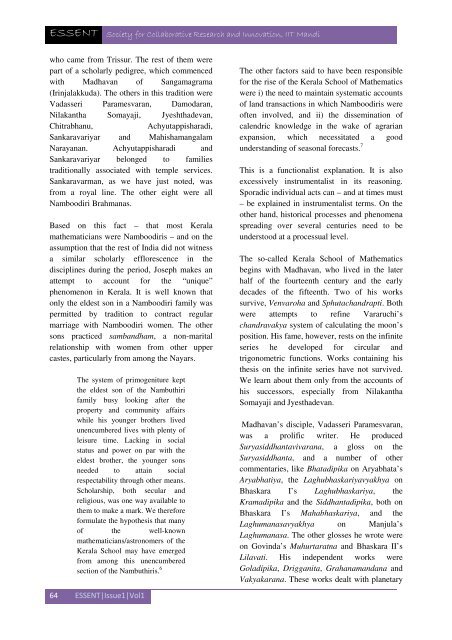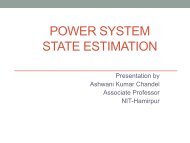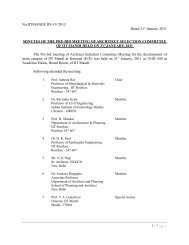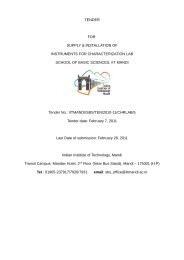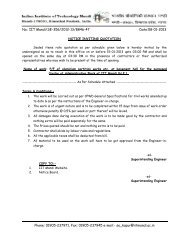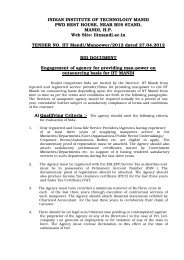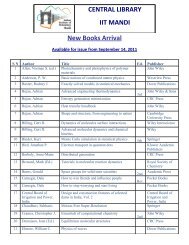Issue1. Vol.1 (April, 2013) - IIT Mandi
Issue1. Vol.1 (April, 2013) - IIT Mandi
Issue1. Vol.1 (April, 2013) - IIT Mandi
- No tags were found...
You also want an ePaper? Increase the reach of your titles
YUMPU automatically turns print PDFs into web optimized ePapers that Google loves.
ESSENT Society for Collaborative Research and Innovation, <strong>IIT</strong> <strong>Mandi</strong>who came from Trissur. The rest of them werepart of a scholarly pedigree, which commencedwith Madhavan of Sangamagrama(Irinjalakkuda). The others in this tradition wereVadasseri Paramesvaran, Damodaran,Nilakantha Somayaji, Jyeshthadevan,Chitrabhanu,Achyutappisharadi,Sankaravariyar and MahishamangalamNarayanan. Achyutappisharadi andSankaravariyar belonged to familiestraditionally associated with temple services.Sankaravarman, as we have just noted, wasfrom a royal line. The other eight were allNamboodiri Brahmanas.Based on this fact – that most Keralamathematicians were Namboodiris – and on theassumption that the rest of India did not witnessa similar scholarly efflorescence in thedisciplines during the period, Joseph makes anattempt to account for the “unique”phenomenon in Kerala. It is well known thatonly the eldest son in a Namboodiri family waspermitted by tradition to contract regularmarriage with Namboodiri women. The othersons practiced sambandham, a non-maritalrelationship with women from other uppercastes, particularly from among the Nayars.The system of primogeniture keptthe eldest son of the Nambuthirifamily busy looking after theproperty and community affairswhile his younger brothers livedunencumbered lives with plenty ofleisure time. Lacking in socialstatus and power on par with theeldest brother, the younger sonsneeded to attain socialrespectability through other means.Scholarship, both secular andreligious, was one way available tothem to make a mark. We thereforeformulate the hypothesis that manyof the well-knownmathematicians/astronomers of theKerala School may have emergedfrom among this unencumberedsection of the Nambuthiris. 6The other factors said to have been responsiblefor the rise of the Kerala School of Mathematicswere i) the need to maintain systematic accountsof land transactions in which Namboodiris wereoften involved, and ii) the dissemination ofcalendric knowledge in the wake of agrarianexpansion, which necessitated a goodunderstanding of seasonal forecasts. 7This is a functionalist explanation. It is alsoexcessively instrumentalist in its reasoning.Sporadic individual acts can – and at times must– be explained in instrumentalist terms. On theother hand, historical processes and phenomenaspreading over several centuries need to beunderstood at a processual level.The so-called Kerala School of Mathematicsbegins with Madhavan, who lived in the laterhalf of the fourteenth century and the earlydecades of the fifteenth. Two of his workssurvive, Venvaroha and Sphutachandrapti. Bothwere attempts to refine Vararuchi’schandravakya system of calculating the moon’sposition. His fame, however, rests on the infiniteseries he developed for circular andtrigonometric functions. Works containing histhesis on the infinite series have not survived.We learn about them only from the accounts ofhis successors, especially from NilakanthaSomayaji and Jyesthadevan.Madhavan’s disciple, Vadasseri Paramesvaran,was a prolific writer. He producedSuryasiddhantavivarana, a gloss on theSuryasiddhanta, and a number of othercommentaries, like Bhatadipika on Aryabhata’sAryabhatiya, the Laghubhaskariyavyakhya onBhaskara I’s Laghubhaskariya, theKramadipika and the Siddhantadipika, both onBhaskara I’s Mahabhaskariya, and theLaghumanasavyakhya on Manjula’sLaghumanasa. The other glosses he wrote wereon Govinda’s Muhurtaratna and Bhaskara II’sLilavati. His independent works wereGoladipika, Drigganita, Grahanamandana andVakyakarana. These works dealt with planetary64 ESSENT|Issue1|Vol1


